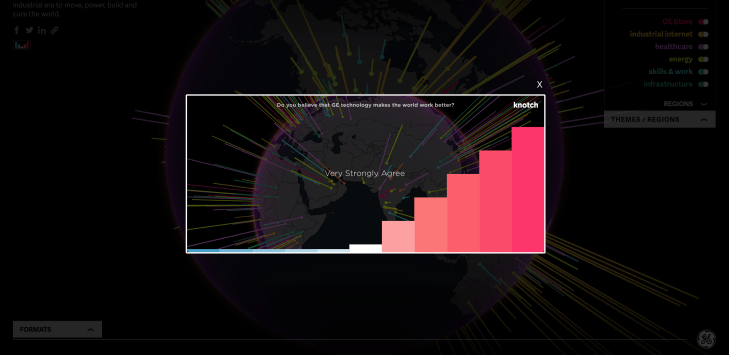Knotch promises marketers a better way to collect user feedback about the effectiveness of their sponsored content. Now it’s announcing that it has received a design patent for its approach.
Basically, when a sponsored article uses Knotch, a survey question pops up at the end, which is supposed to help advertisers assess your state of mind after reading the article. The big difference is that you don’t answer with words or number ratings, but instead use a “temperature” scale to describe your feelings — the red end of the spectrum reflects more positive feelings, while blue indicates something more negative.
This might sound a bit gimmicky, but Knotch says this has led to a dramatic increase in response rates compared to most user surveys. A traditional survey might only get responses from 1 percent of the people who see it, while Knotch surveys see response rates as high as 25 percent.
CEO Anda Gansca said Knotch’s approach is more effective because it’s an intuitive way for users to communicate their feelings. Or, to put it in slightly more grandiose terms, she said temperature works as a “universal metaphor,” and when you see the Knotch temperature scale, “It’s something that taps into your subconscious.”
As for the patent (which is not yet available on the US Patent and Trademark Office’s online database), Gansca said it covers “the idea of capturing sentiment in granularity of color.”
(Update: You can now view the patent online.)
She acknowledged that for many in the tech world, patenting an idea seems much less important than actually building a product that people want to use, but she added, “For us, it helps because this is going to deter certain parties from copying us, and it’s symbolic — we get to own something we feel that we discovered.”
Gansca also said the patent reflects Knotch’s commitment to design, which goes back to its roots as the maker of an opinion-sharing app for consumers, and the fact that it still has its own chief creative officer, Aron Tzimas.
“Data companies are not known for having great design or any design at all,” she said. “They usually have a table of data you’re looking at it and saying, ‘What?’ But we’re keeping ourselves to the same design standards that we [used] for the consumer side of our company.”
